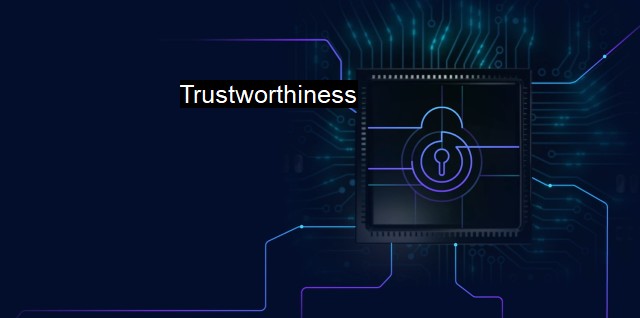What are Trustworthiness?
The Critical Importance of Trustworthiness in Cybersecurity and Antivirus Software: Let's Discuss Reliability, Branded Reputation, Transparency, and User Privacy
Trustworthiness is a principle that allows individuals and organizations to have confidence in the integrity, reliability, and ability of a certain system, individual, or process to serve its intended purpose without hampering or compromising its functioning. It evokes a sense of surety and reliability that a component task will be executed correctly and with optimal security. trustworthiness plays a pivotal role.Cybersecurity incorporates protecting internet-connected systems including hardware, software and data from cyber attacks. With an increasing number of malicious threats, ensuring system trustworthiness has become an essential requirement for cybersecurity. The scale and consequences of cyber attacks have raised concerns over the dependability of security mechanisms, emphasizing the demand for trustworthiness in cybersecurity.
Trustworthy cybersecurity systems and antivirus software are designed to create and maintain an environment that anticipates, discourages, detects and defends against attacks from cyber miscreants. For instance, the firewall should be trusted to accurately filter data and the antivirus system can be relied upon to indentify and remove malicious software. A trustworthiness factor means users can depend on them to protect their digital assets.
Validating the trustworthiness of these digital protection tools begins by ensuring the source and methods through which cybersecurity systems and antivirus software are obtained are authentic and reliable. A trusted source is one that is identified and accepted widely as being secure and reliable by the cybersecurity community. Trust is also placed in the capabilities of the software to effectively detect and respond to potential threats, alongside regular updating for addressing new challenges and threats.
Trustworthiness in cybersecurity also incorporates employing trustworthy vendors who regularly update their security suites to target novel malicious threats. The regularly updated software signifies that the provider values system trustworthiness and is committed to safeguarding the users' data. The trustworthiness of antivirus software is then elevated as it is built to learn from and adapt to new malware and attacks as they are identified globally.
User trust and system trustworthiness go hand in hand. A breach of cybersecurity often hits hard at user trust in the efficacy of online systems. This decreases user trust levels. Trustworthiness of a cybersecurity system can be boosted by including transparency in technological processes and clear rationality behind false-positive and false-negative rates amidst threats.
In today's age of ever-evolving cyber threats, an essential approach is to ensure the trustworthiness of cryptographic mechanisms, necessary for secure communication. Trustworthiness in encryption algorithms suggests that they are dependable for maintaining confidentiality and identity during conversation between multiple systems or users.
Organisations tend to use trustworthiness measures in another significant area: cloud storage and computing. businesses invariably require assurances the cloud provider is robust in its security and capable of safeguarding sensitive and valuable data, upholding trust in their cybersecurity measures.
Trustworthiness is an asset striving toward ensuring substantial control over data correction and protection. The integrity and reliability provided by a trustworthy cybersecurity system or antivirus software enable the users to interact freely on digital platforms with much less worrying about potential threats.
As it is often said in the security community "Trust, but verify." Though a cybersecurity system or antivirus software may be built for trustworthiness, we should not overlook the fact the presence of zero risk in the cyber world could still be in question. Therefore, maintaining a prudent and responsible approach to personal digital security is of utmost importance while relying on trustworthy systems.

Trustworthiness FAQs
What is trustworthiness in the context of cybersecurity and antivirus?
Trustworthiness in cybersecurity and antivirus refers to the reliability and effectiveness of the security measures put in place to protect against cyber threats. A trustworthy antivirus program should be able to detect and prevent malicious activity, while also maintaining the privacy and safety of user data.How do I determine the trustworthiness of an antivirus program?
To determine the trustworthiness of an antivirus program, you should look for reviews and ratings from reputable sources, such as independent testing labs and industry experts. Additionally, check if the antivirus program has a strong track record of detecting and preventing cyber threats, and if it is frequently updated to address new security risks.What role does trustworthiness play in overall cybersecurity hygiene?
Trustworthiness plays a crucial role in overall cybersecurity hygiene, as it ensures that the security measures put in place are reliable and effective. Without trustworthiness, users may be exposed to cyber threats such as malware, spyware, and ransomware, which can result in data breaches, financial loss, and reputational damage.How can I ensure that my online transactions are secure and trustworthy?
To ensure that your online transactions are secure and trustworthy, you should use a secure and reputable payment service, such as PayPal or Stripe. Additionally, make sure that the website you are transacting on has a valid SSL certificate and uses HTTPS encryption to protect your data. Finally, use a trusted and up-to-date antivirus program to protect against malware and other cyber threats.| | A | | | B | | | C | | | D | | | E | | | F | | | G | | | H | | | I | | | J | | | K | | | L | | | M | |
| | N | | | O | | | P | | | Q | | | R | | | S | | | T | | | U | | | V | | | W | | | X | | | Y | | | Z | |
| | 1 | | | 2 | | | 3 | | | 4 | | | 7 | | | 8 | | |||||||